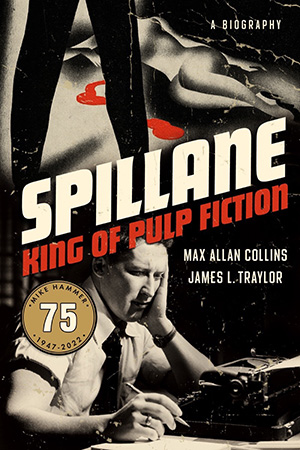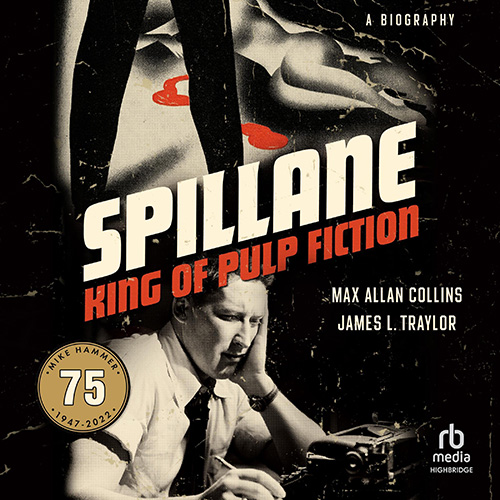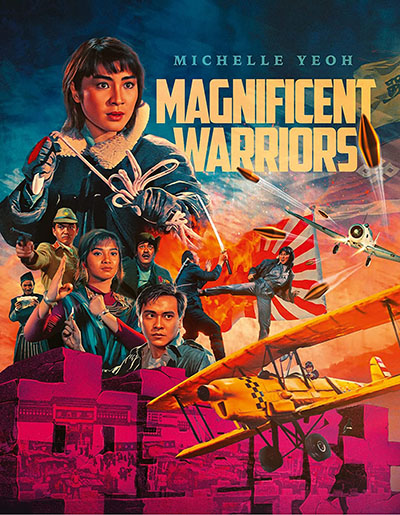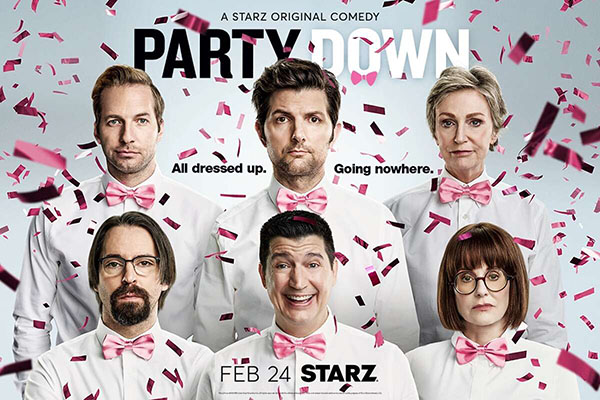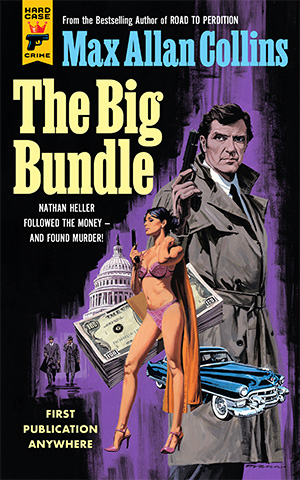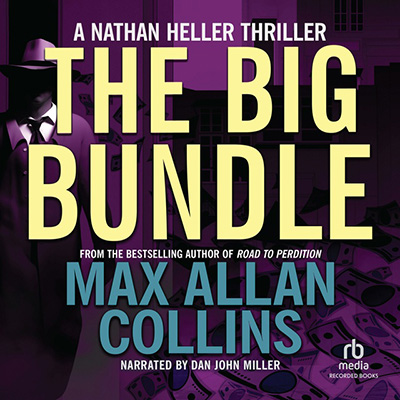I’ve spent a lot of time here, at this update/blog entries, over the past year or so talking about Mickey Spillane and Mike Hammer, and my efforts to complete Mickey’s work and to specifically celebrate the 75th anniversary of Mike Hammer’s first appearance in I, The Jury.
A good deal of these posts have centered upon the biography written by Jim Traylor and me, Spillane – King of Pulp Fiction (and published by Mysterious Press). The response to that book has been terrific, and I have reason to hope our bio will be considered the definitive work on Mickey and will play a major role in getting this great and very influential mystery writer his due.
Lately here I’ve discussed certain Spillane-centric efforts of myself and longtime collaborator Phil Dingeldein, the Director and Photography (as well as Editor) on my indie films Mommy, Mommy’s Day, Real Time: Siege at Lucas Street Market and Eliot Ness: An Untouchable Life. We have expanded my 1998 documentary, Mike Hammer’s Mickey Spillane, from 47 minutes to 61, covering the later few years of Mickey’s life and work as well as my project of completing his unfinished manuscripts (at his request in the final weeks of his life).
We also – and as I’ve reported here, did so last-minute and somewhat on the fly – recorded the performance last September in Muscatine, Iowa, of my Golden Age Radio-style play, Mickey Spillane’s Encore for Murder, capturing Gary Sandy’s charismatic performance as Hammer (he had starred in productions of Encore at Owensboro, Kentucky, and Clearwater, Florida, previously, and of course was Patty McCormack’s co-star in Mommy’s Day).
This fall the expanded Mike Hammer’s Mickey Spillane with Encore for Murder presented as a second feature will be out on home video from VCI Entertainment. VCI will be taking both the documentary and the edited/recorded play performance out to the streaming services, too. We are also in early stages of putting together definitive versions of Mommy and Mommy’s Day, having finally located their un-Filmlooked masters (not coincidentally Mickey appeared as Mommy’s lawyer in both).
Things on these updates will begin swinging back toward my own (and Barb’s) work, as only two more Hammer novels (one already delivered, Dig Two Graves) are planned. That may change, as Skydance has optioned all the Hammer novels (the solo Spillane and collaborative Spillane/Collins ones). A renewed interest in Mike Hammer and his creator, due to a new big-deal movie, could inspire me to go back to the files and see what of Mickey’s unfinished work remains.
Encore for Murder has led to a reawakening of my interest in filmmaking. I’ve continued to do the occasional screenplay (director David Wexler is prepping Cap City, based on the Spillane/Collins novella, “A Bullet for Satisfaction”) but I had thought, after my heart surgery and other medical fun-and-games, my moviemaking days were over, save for the occasional scripting job.
But working with editor Chad Bishop has revitalized me, and so we are moving from Encore – that little “movie” that sort of willed itself into existence – to Blue Christmas, based on my novella, a sort of Scrooge/Maltese Falcon mash-up. We have only a couple of more weeks on our Indiegogo campaign to raise $5000 that will provide some of the matching funds needed if our Greenlight grant comes through (and if it doesn’t, those funds will go into the production itself).
A good number of you have supported this effort and I appreciate it…very much. I have been offering perks here that are not part of the Indiegogo descriptions of levels of participation. What I’m doing is working with contributors to fill items on their M.A.C. want list, according to the level of their contribution; most of you will be thanked on screen. Here’s a window on the Indiegogo page. We are at nearly $3000 at this stage.
Anybody who contributes $35 will be recognized on screen. (Keep in mind my postage and handling for your perk, once we’ve decided via e-mail what you’d like, comes out of that $35.)
Our budget is probably going to be around $150,000, with “in kind” figured in – in kind covers things like meager-to-no salaries for actors and crew, local businesses supporting us with free lodging and food, etc. We are seeking a relatively small amount but need it to secure matching funds, often a requirement with grants, or to help cover cash outlay. Much of what we’re doing is volunteer and includes the support of Muscatine Community College, where we’ll be shooting much of the production in their Black Box theater.
Really, I anticipate putting on screen something like looks like at least a half-million-dollar production. (We did Real Time and Eliot Ness for $10,000 and $15,000 respectively.)
I am a believer in the notion that if the story is strong, and the performances and production professional
enough, you don’t have to have huge stars and Hollywood production values to make a satisfying movie. It’s a small miracle that we’ve done five features, two feature-length documentaries, and three award-winning shorts right here in this corner of Iowa. If you want to help us work another minor miracle, consider stepping up.
We are coming down the pike here. If you’ve been thinking about participating, now’s the time.
While I did not attend the Edgars this year – I can lose so much more easily at home than in a New York hotel – I was asked by the MWA to write about Mickey for their nifty program book. In that publication, a number of mystery writers were celebrated by other pros in the field in brief essays about why each of the chosen artists were worth, well, choosing.
This is what I wrote:
by Max Allan Collins
In the late ‘50s and early ‘60s, TV private eyes were the rage. Among the first was Mickey Spillane’s Mike Hammer (1958) with Darren McGavin, which I started watching when I was ten. Video P.I. series were often directly based on literary sources – The Thin Man, Phillip Marlowe, 77 Sunset Strip, Perry Mason – with the biggest hit, Peter Gunn, a Hammer variation. I haunted the spinner racks, using my buck a month allowance to buy 25-cent paperbacks by Dashiell Hammett and Raymond Chandler. Spillane books were considered “dirty,” and for a while I satisfied my urge just reading the jaw-dropping endings. I researched Hammett, Chandler and Spillane, discovering the first two were admired and celebrated, whereas Spillane was attacked as juvenile delinquent-breeding trash. I loved all three, so this made no sense to me. So began a lifetime of reading, defending and eventually getting to know Mickey, and having the privilege of turning his unfinished material into books.
Mickey defies literary appraisal – he is an unpretentious blue-collar ex-comic book writer, his first seven novels (six Mike Hammer mysteries) his most popular, significant work. But his amazing first and last chapters, distinctive first-person voice, and noir poetry on every page makes him more than just a pop phenomenon. For reasons explored in Mickey Spillane – King of Pulp Fiction (2023, co-written by James L. Traylor and me), he stopped writing novels for ten years at his popular peak. Returning for a longer run in the ‘60s and early ‘70s, he was back on the bestseller lists but overshadowed by Ian Fleming, the obscure British thriller writer Mickey’s publisher promoted during their star’s absence. Much of Mickey’s later career was media-driven – he starred in two movies (as Hammer in The Girl Hunters, 1964) and spoofing himself in an eighteen-year (!) run of Miller Lite commercials. A household name in the 20th Century, Spillane demands reappraisal as the writer who re-invented private eye fiction, and whose success sparked the creation of paperback originals, with Hammer the template not just for Bond but Dirty Harry, John Shaft and every vigilante-tinged tough guy who came after.
Here’s a nice gallery of Hard Case Crime covers, including some of mine. [The site creates galleries from Tumblr hashtags and may contain NSFW content –Nate]
Here’s a mixed review from the somewhat accurately self-described B-Movie Enema. What this reviewer doesn’t understand is that reviewing a movie off You Tube is not the ideal place to judge its lighting, production values or audio (very hissy on You Tube, we’re told – like Gomer Pyle once said, “Surprise, surprise!”). Still, he makes some interesting points. But the major point he makes, inadvertently, is that we are lucky we found the original pre-Filmlook masters for a re-release of both Mommy movies next year.
By the way, the same reviewer liked Mommy a lot more. A lot. He really appreciates Rachel Lemieux’s terrific performance.
I do hope this reviewer will revisit the sequel when he realizes (a) you shouldn’t judge how a movie looks or sounds on You Tube, and (b) you shouldn’t expect the sequel to be exactly like the original.
M.A.C.
